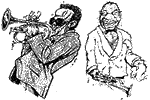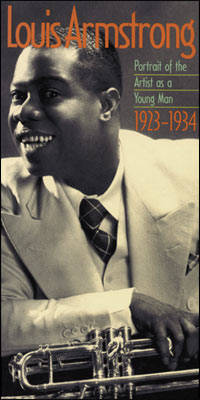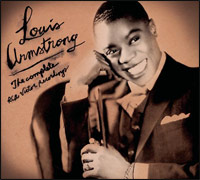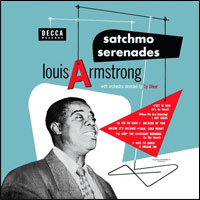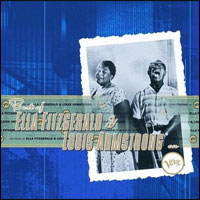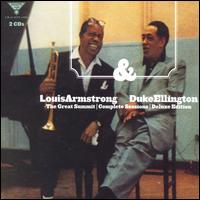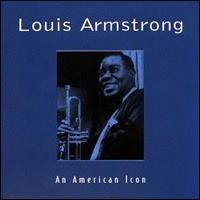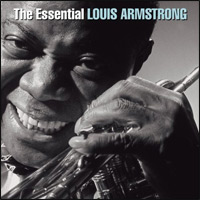Randy's Rodeo
music that rocks, rolls, swings, and twangs
| Artist Index | Song Index | Radio | Home |
|
Music Reviews Special Features Information Support Me |
Sock it to me, Santa!
Satchmo recorded prolifically for nearly 50 years, and throughout his career he jumped from label to label, including Okeh, Columbia, Brunswick, RCA Victor, Decca, Commodore, Verve, Roulette, Kapp, Mercury, and ABC-Paramount. Plus, he recorded many songs in his repertoire multiple times. The result is a vast, dizzying legacy for collectors to sift through. There are hundreds - perhaps thousands - of Armstrong CD's on the market, even more so now that most of his recordings have entered the public domain outside the United States. Just about all of those albums overlap, and nearly every one contains some gems. So, where to start? That's not an easy question to answer.... Satchmo was born to a poor family in New Orleans, Louisiana, and he began playing professionally at a very young age. He didn't start recording till 1923, and in the beginning he blew his extraordinary, groundbreaking solos in bands like King Oliver's Creole Jazz Band and Clarence Williams' Blue Five. With Oliver, Armstrong waxed "Sugar Foot Stomp" which, when recorded again as "Dipper Mouth Blues," rose to #9 on the national charts in early 1924. (To confuse matters even further, King Oliver recorded another version of "Sugar Foot Stomp" in 1926 for Decca with the Dixie Syncopators - no Satchmo this time.) "Dipper Mouth," by the way, was one of Armstrong's nicknames, as was "Satchel Mouth" which, as you might surmise, got shortened to "Satchmo." Later in life, people just called him "Pops" - inferring both respect and affection. [close]
It's worth noting, however, that Armstrong and Bechet had already recorded "Cake Walking Babies From Home" a few weeks earlier, moonlighting under the name Red Onion Jazz Babies. The vocalist on that session was listed as Josephine Beatty - one of Alberta Hunter's pseudonyms. Both recordings are wonderful, but the Clarence Williams' version swings hardest, and it rose to #13. During his early years, Armstrong also worked with other future New Orleans legends like Kid Ory, Baby Dodds, Johnny Dodds, Johnny St. Cyr, Fletcher Henderson, and Lil Hardin (destined to be Armstrong's second wife). Soon, he would also collaborate with Lionel Hampton, Barney Bigard, Jack Teagarden, Don Redman, Earl "Fatha" Hines, and vocalist Velma Middleton, who years later would become Satchmo's onstage foil. Additionally, Satchmo accompanied some of the finest blues singers of his day, most famously Bessie Smith ("St. Louis Blues"), but also Ma Rainey ("Countin' The Blues"), Bertha Hill ("Trouble In Mind"), Sippie Wallace ("Baby I Can't Use You No More"), Victoria Spivey ("How You Do It That Way?"), and Trixie Smith ("Railroad Blues"). In 1930, he even recorded with country music pioneer Jimmie Rodgers ("Blue Yodel No. 9"). But, the creative stars aligned when Louis Armstrong signed to Okeh Records in 1925 and formed his own band - the Hot Five, featuring Kid Ory on trombone, Johnny Dodds on clarinet, Lil Hardin on piano, and Johnny St. Cyr on banjo. The line-up would shift constantly and eventually expand into the Hot Seven; other prominent members over the years included blues guitarist Lonnie Johnson, clarinetist Don Redman, and (especially) pianist Earl Hines. The numerous recordings Armstrong and his Hot Fives and Sevens made from 1925 to 1928 are definitive and essential - the jazz version of the Sistine Chapel or Einstein's theory of relativity. Therefore, Sony's boxed set, The Complete Hot Fives and Hot Sevens Recordings (2000), is something akin to the Magna Carta. (Some listeners, by the way, swear by the JSP Records version of the same music. Also, Sony released a single disc sampler, Best Of Louis Armstrong: The Hot Five And Seven Recordings, two years later.)
Louis Armstrong is, without a doubt, a jazz legend as valid and vital as Thelonious Monk or Charlie Parker. But, unlike those artists, Louis had hit records - almost 100 by my count. And, most of them featured Armstrong's ragged, raspy voice as prominently as his pure, clarion horn. Certainly, there was an element of novelty to his singing, and in pure vocal ability, Louis couldn't hold a candle to, say, vocal virtuosos Jimmy Rushing or Joe Williams. But, he had, well, something. People responded to it. Call it feel, or instinct, or empathy - but he could sell a song like nobody's business. Listen, for instance, to his mid-50's duets with Fitzgerald - one of the greatest singers in jazz history. Satch and Ella sing some tough stuff - Gershwin, Ellington, Porter - and he hangs with her every step of the way. Tony Bennett - no slouch himself - once claimed, "Louis Armstrong taught practically every pop singer of the day how to phrase correctly. Without his basic phrasing one cannot be a good pop singer." But, back to our story... In 1929, Armstrong's marriage to Hardin was on the rocks, and he also broke out of the Hot Fives and Sevens format that had been so inspirational for him. Instead, he set his sights on the mainstream and began a long series of recordings - usually billed as Louis Armstrong & His Orchestra - that would ultimately encompass the entire breadth of American popular song. Highlights from this era include Satchmo's definitive versions of Fat Waller's "Ain't Misbehaving" and Earl Hines' "You Can Depend On Me"; masterful interpretations of pop standards like "Body & Soul," "All Of Me," and "Stardust"; and Armstrong's first recordings of two songs that would become his signatures, "When It's Sleepy Time Down South" and "When You're Smiling (The Whole World Smiles With You)."
Jazz evolved rapidly during its first few decades, but after his volcanic first decade, Louis Armstrong didn't. Certainly, he matured - particuarly as a singer - but for the rest of his career Louis seemed pretty happy just being Louis (and thank God for that...). As a result, though, the rise of swing, bebop, and jump blues conspired to make Satchmo sound like an anachronism. Further, Armstrong increasingly recorded in the studio with a large orchestra - usually to great effect, even if you couldn't quite call it jazz. Eventually, he formed a band called the All Stars that consisted of "hot" New Orleans-style players like (at various times) Jack Teagarden, Sid Catlett, Buddy Bigard, Earl Hines, Cozy Cole, and singer Velma Middleton. The All Stars made plenty of records with Louis, but their primary role was as a show band. Even as Satchmo was scaling the charts with (admittedly charming) show biz schtick like "Kiss Of Fire" and "A Kiss To Build a Dream On," the All Stars were setting fire to stages all over the world. You can witness this phenomenon on live sets like Satchmo At Symphony Hall (1947), The California Concerts (1951-1955), The Great Chicago Concert (1956), and The Katanga Concert (1960), mostly released for the first time on compact disc long after Armstrong's death. These performances - contrasted with his sometimes maudlin studio recordings - illustrate why critics call Louis' middle period "hit and miss." Sets like the 4-CD box The Complete RCA Victor Recordings (1997), however, show there were plenty of hits (literally and figuratively) to counterbalance the misses. Sugar: The Best Of The Complete RCA Victor Recordings is a wisely chosen, more affordable selection from the box; I also recommend RCA's double-disc package A 100th Birthday Celebration. Note, however, that The RCA Victor Recordings encompass three separate periods: most importantly 1932-1933, but also 1946-1947 and two songs from 1956 - though not Louis' 1970 album, Louis Armstrong & Friends (reissued by RCA but recorded for a small label). And, these RCA discs replaced earlier, very similar Complete and Best Of releases - different packaging, same track listings.
Switching to Decca in 1935, Armstrong continued much in the same vein as with RCA. He recorded consistently for the label for nearly 20 years, then occasionally thereafter. He waxed a huge amount of material at Decca, assaying a wide range of styles - everything from hot jazz with the All Stars to novelties like "Gone Fishin'" with Bing Crosby. The most important material is captured on loose, incomplete series called "The Original Decca Recordings" (see list); the final volume, Highlights From His Decca Years, is probably the best option for casual fans. Even less complete - but a whole lot of fun - is Satchmo Serenades, a 1953 LP compiling previously released vocal numbers; the CD reissue includes six bonus tracks, including several from a similar 1955 LP, Satchmo Sings. (A few notes: due to a musician's union recording ban, Louis recorded very little for Decca from the middle of 1942 though the end of 1945. However, radio transcriptions and military V-discs abound. And, in Europe, the Decca recordings - and anything over 50 year old - have entered the public domain, giving rise to unlicensed sets like Definitive Recordings' Complete Decca Studio Master Takes 1935-1939 and 1940-1949. Impressive, but caveat emptor. On the other side of the coin, mail-order house Mosaic Records released a superb 6-CD box in 1993 called The Complete Decca Studio Recordings of Louis Armstrong and the All Stars; good luck finding that one - try Amazon or eBay.) Starting in 1954, Louis began hopping labels, and he never really stopped. Of particular note are the handful of tribute records he made for Columbia including Louis Armstrong Plays W.C. Handy (1954), Satch Plays Fats (1955), and Satchmo Plays King Oliver (1960), plus a pretty "out there" concept album conceived by Dave Brubeck called The Real Ambassadors (1961). At Columbia, Satchmo also scored a big hit with his timeless take on Kurt Weill's "Mack The Knife" (1956), which is included with new recordings of older hits on Louis Armstrong's Greatest Hits (1967). I also recommend Satch Blows The Blues (2002), a compendium from the Columbia vaults stretching from 1928 to 1954.
Armstrong's last great hurrah as a jazzman were his 1961 sessions with Duke Ellington and the All Stars for Roulette Records, originally issued as Together For The First Time and The Great Reunion, and then compiled in 2000 as The Great Summit, both in single-disc Master Takes and double-disc Complete Sessions editions. Finally, Satchmo performed in several movies over the years from Pennies From Heaven (1936) to Hello Dolly! (1969). Rhino Records compiled highlights from several of these on Now You Has Jazz: Louis Armstrong At MGM (1997), including the otherwise rare title song with Bing Crosby (a minor hit at #88) from High Society (1956). In recent years, Armstrong's songs have been featured prominently in many films, including Good Morning Vietnam (1988), which lifted "What A Wonderful World" into the Top 40. Originally, the 1967 single "bubbled under" in the United States but hit #1 in England in early 1968.
The last few years of Satchmo's life brought several projects that illustrate why jazz purists lost interest in his work - and why he become such a totem outside the rarified world of the jazz academe. Check out Disney Songs the Satchmo Way (1966) - no kidding, it's cute! Of course, there's the heavily orchestrated "What A Wonderful World" (1967) and a similarly lovely song called "We Have All The Time In The World" from the 1969 James Bond film On Her Majesty's Secret Service. His last album, Louis Armstrong And His Friends, was recorded for Amsterdam Records in 1970 and featured such dubious choices as "Give Peace A Chance." (Much later, it was reissued on CD by RCA as What A Wonderful World, which is not to be confused with his 1968 album of the same name.) Louis died in 1971, but before his death, he was even recording a country album, which has (happily, perhaps) gone unfinished and unreleased. So, back to our original question: How do you collect all this stuff? Well, Hip-O Records' 3-CD box An American Icon (1999) helps a lot. It covers Louis' career from after World War II nearly to the end. Impressively, the set surveys Decca, RCA, Columbia, Verve, Roulette, Kapp, Mercury, ABC-Paramount, and GNP Crescendo recordings from that period; together with Columbia's Portrait Of The Artist As A Young Man, American Icon allows novices to (nearly) cover Satchmo's career in two fell swoops. (For those of you keeping score, that leaves a gap right in the middle - Louis' Decca recordings from 1935 through 1946.)
In early 2001, Louis Armstrong's estate released hundreds of tapes of conversations that Satchmo made (often surreptitiously) with a portable tape recorder - probably the same machine on which he made his final recording, a recitation of "'Twas The Night Before Christmas" in 1971. The tapes reveal a man far more complex and angry than his public ever guessed. You see, during the tempestuous 60's, many members of the African American community came to view Armstrong with contempt. He was seen as a smiling fool and, worse, a lackey to white interests. Certainly, Louis put on a happy face in public - in the interest of commerce and, I believe, racial harmony. But, he spoke out when he needed to (during the 1957 Little Rock integration showdown, for instance), and privately, he was profoundly bitter about the way he and other people of color were often treated. One hopes that these tapes, along projects like Complete Hot Fives and Sevens, will lead to a revision of the black view of Armstrong - one consonant with his rightful status as a giant of jazz and true American hero. [top of page]
Your witty comments, impertinent questions, helpful suggestions, and angry denials are altogether encouraged. Submit feedback via email; submissions will be edited and posted at my discretion. |
|
|||||||||||
Navigation Artist Index Song Index Randy's Radio Home Top Of Page Music Reviews Alternative Blues Books Christmas Classic Rock Country Jazz Lounge Special Features History Of Randy's Rodeo Sex Pistols Motown Records Halloween Valentine's Day Information About Me Feedback Links User's Guide Support Me Amazon iTunes Sheet Music Plus © 1999-2025 Randall Anthony, www.hipchristmas.com and www.randysrodeo.com |
|||||||||||||
